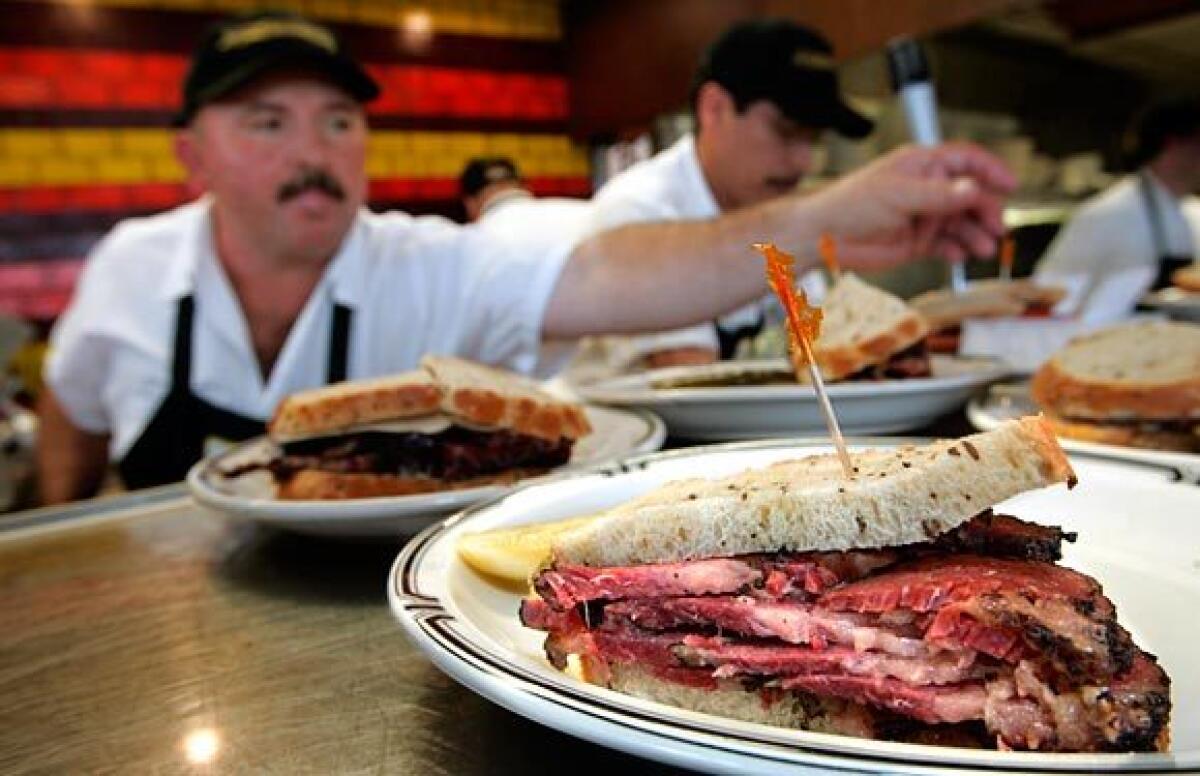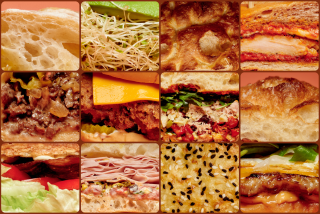The deli capital? It’s L.A.

It was in rural Kansas, near the geographical center of America, that David Sax hit rock bottom in his search for the perfect deli sandwich. It happened innocently enough, in an Arby’s. He had ordered a Reuben.
“What I got was this horrible abomination of plasticized cheese that tasted like it had come from a napalm plant,” he says. “Meat that had been pressed and pumped and vacuumed and torn apart to increase its yield in water but had no flavor. Bread that was just white bread painted a dark rye color. It was horrendous. And it was microwaved. I had two bites and that was it.”
But if Sax found the nadir of the Reuben, he also found its zenith. And -- perhaps surprisingly -- he didn’t find it in New York, the birthplace of the Jewish deli; he found it here in Los Angeles.
“It’s a very difficult business to be in,” Sax says, “but the [delis] that are most inspiring, the ones that people cling to, the ones that people enshrine for years and years are the traditional Jewish delis. And Los Angeles just happens to have more of them than any city I’ve been to.”
To die-hard deli aficionados and sandwich fans, this assertion is heresy. It certainly wasn’t what Sax, a Toronto native who now lives in Brooklyn, expected to discover. But in “Save the Deli,” a book that traces the rise and fall of Jewish delicatessens from the shtetls of Eastern Europe to the suburbs of middle America, he makes that very claim.
On a two-month cross-country trip, Sax hit all the major deli hubs: Los Angeles, Chicago, San Francisco and, of course, New York, even working for an evening as a counterman at the legendary Katz’s deli on Manhattan’s Lower East Side. But he also fanned out across North America to Denver; Detroit; Scottsdale, Ariz.; St. Louis; Cleveland; Las Vegas; Ft. Lauderdale, Fla.; Montreal; Toronto; and a dozen other cities. He even made a trip across the Atlantic to visit delis in London, Brussels, Paris and Krakow, Poland, one of the birthplaces of the modern Jewish deli.
History in every bite
Bound by “a proclivity for garlic and onions, and a reverential worship of schmaltz, or rendered fat,” Sax writes, the Ashkenazi Jewish cultures of Germany, Poland, Romania, Hungary and the Russian empire developed kosher versions of local meat specialties. When centuries of diaspora living met America’s abundant beef supply in New York in the late 1800s, the deli staples of pastrami, corned beef and tongue were born.
Selling from pushcarts, early Yiddish food vendors faced increasing restrictions (a familiar conflict to foodies aware of recent county and city attempts to curb taco trucks) and evolved to bricks-and-mortar restaurants. But it was America’s obsession with the sandwich, according to Sax, that catapulted Jewish delis “from an obscure immigrant food to an American cuisine.” In Los Angeles, delis had yet to make their mark; that would come later as the descendants of New York’s first wave of Jewish settlers migrated west.
The 1930s were boom deli years, with a second generation of immigrants finding more stability and prosperity while catering to a clientele concentrated in New York’s Jewish enclaves.
At the same time, the traditional kosher deli gave rise to the kosher-style deli, also known as the Jewish or New York deli, that predominates today. Uninhibited by dietary restrictions that forbade observant Jews from consuming meat and milk together, they broadened their menu and clientele. Ergo, the Reuben, the ultimate assimilated sandwich: corned beef and sauerkraut topped by Swiss cheese and creamy Russian dressing.
Driven by the rise of supermarkets, decreased Jewish immigration, changing eating habits, fewer mono-ethnically Jewish neighborhoods and uniquely low profit margins in the deli business, the post-World War II years marked the beginning of the decline for delis.
“In the 1930s there were something along the lines of 1,500 kosher delis in New York,” Sax says. “Now, there are about two dozen in all of New York City. That’s an 80% to 90% decline. This has been echoed in other cities around the country.”
Yet Los Angeles delis have managed to thrive in a niche market. Acre for acre, Sax maintains that Southern California boasts “more delicatessens of higher quality, on average, than anywhere else in America.” He commends Nate ‘n Al in Beverly Hills; Factor’s in Pico-Robertson; Junior’s in West L.A.; Greenblatt’s on the Sunset Strip; Art’s in Studio City; Canter’s in the Fairfax district; and the various Hat locations.
But Sax reserves his highest praise for Langer’s, near MacArthur Park -- where the pastrami sandwich “encapsulates perfection at every turn” -- and Brent’s in Northridge and Westlake Village -- which he calls “absolutely sensational.”
Where New York delis tend to be cramped and covered in an intangible layer of old world schmutz, Los Angeles delis are the height of midcentury, suburban modernity. If New York delis are as intimate and familiar as your bubbe’s kitchen, then Los Angeles delis, with their spacious banquettes, polite wait staff and abundant parking, are like younger, sexier spokesmodels for the deli world.
Metaphors aside, the most successful delis usually share three traits: They own their own land and aren’t subject to harsh rent increases; they often keep the business in the family; and they don’t skimp when it comes to the quality of their core deli fare.
“Any deli where you can order lobster should be suspect, even if you’re not kosher,” Sax says. But he’s aware that rules are meant to be broken. Sax was initially skeptical of Brent’s, because of its vast menu, but he was won over with one bite of their house-made kishke, a rarely served sausage made of beef intestines stuffed with schmaltz, matzo meal and, often, organ meat.
Community spirit
The other secret of L.A.’s delis is that its owners are a tight-knit bunch who usually cooperate with each other. When Nate ‘n Al installed a new computer system, owners David and Mark Mendelsohn went around to other local delis to help them set up their computer systems. Sax can’t imagine that happening elsewhere.
“I’ve been to delis, especially in Florida, and when you ask if there are any other delis, they say, ‘There are no others,’ even if you can see another deli in the strip mall across the street,” Sax says. “The attitude that prevailed in New York for a long time is that if another deli goes out of business, ‘Hey, more for me.’ ”
It’s not simply a philosophical error but a pragmatic one, in Sax’s opinion. If the deli, whether as a hallowed eatery or as the civilian repertoire of American Jewish culture is to be saved, then Los Angeles is the case study. “The more delis that there are, the more people are going to want to eat at delis because it’s visible, it’s there in their minds,” Sax says. “I thought that was the lesson L.A. could teach everyone else.”
More to Read
Eat your way across L.A.
Get our weekly Tasting Notes newsletter for reviews, news and more.
You may occasionally receive promotional content from the Los Angeles Times.










